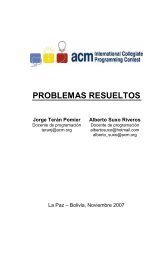Soluciones y Explicación de los problemas ACM ... - ICPC Bolivia
Soluciones y Explicación de los problemas ACM ... - ICPC Bolivia
Soluciones y Explicación de los problemas ACM ... - ICPC Bolivia
You also want an ePaper? Increase the reach of your titles
YUMPU automatically turns print PDFs into web optimized ePapers that Google loves.
Explicaciones a <strong>los</strong> <strong>problemas</strong> South American Regionals 2008 33<br />
Problem G<br />
Electricity<br />
Source file name: electricity.c, electricity.cpp or electricity.java<br />
Martin and Isa stopped playing crazy games and finally got married. It’s good news! They’re<br />
pursuing a new life of happiness for both and, moreover, they’re moving to a new house in a<br />
remote place, bought with most of their savings.<br />
Life is different in this new place. In particular, electricity is very expensive, and they want to<br />
keep everything un<strong>de</strong>r control. That’s why Martin proposed to keep a daily record of how much<br />
electricity has been consumed in the house. They have an electricity meter, which displays a<br />
number with the amount of KWh (kilowatt-hour) that has been consumed since their arrival.<br />
At the beginning of each day they consult the electricity meter, and write down the consumption.<br />
Some days Martin does it, and some days Isa does. That way, they will be able to<br />
look at the differences of consumption between consecutive days and know how much has been<br />
consumed.<br />
But some days they simply forget to do it, so, after a long time, their register is now incomplete.<br />
They have a list of dates and consumptions, but not all of the dates are consecutive. They want<br />
to take into account only the days for which the consumption can be precisely <strong>de</strong>termined, and<br />
they need help.<br />
Input<br />
The input contains several test cases. The first line of each test case contains one integer N<br />
indicating the number of measures that have been taken (2 ≤ N ≤ 10 3 ). Each of the N following<br />
lines contains four integers D, M, Y and C, separated by single spaces, indicating respectively<br />
the day (1 ≤ D ≤ 31), month (1 ≤ M ≤ 12), year (1900 ≤ Y ≤ 2100), and consumption<br />
(0 ≤ C ≤ 10 6 ) read at the beginning of that day. These N lines are increasingly or<strong>de</strong>red by<br />
date, and may inclu<strong>de</strong> leap years. The sequence of consumptions is strictly increasing (this is,<br />
no two different readings have the same number). You may assume that D, M and Y represent<br />
a valid date.<br />
Remember that a year is a leap year if it is divisible by 4 and not by 100, or well, if the year is<br />
divisible by 400.<br />
The end of input is indicated by a line containing only one zero.<br />
The input must be read from file electricity.in.<br />
Output<br />
For each test case in the input, your program must print a single line containing two integers<br />
separated by a single space: the number of days for which a consumption can be precisely<br />
<strong>de</strong>termined, and the sum of the consumptions for those days.<br />
The output must be written to standard output.



